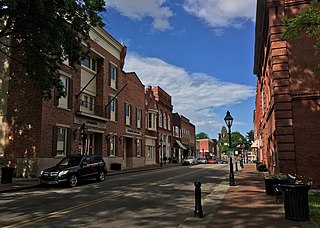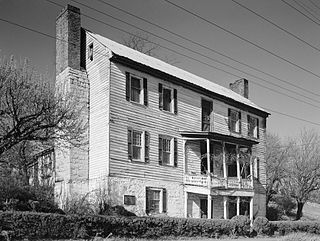
Rogersville is a town in, and the county seat of, Hawkins County, Tennessee, United States. It was settled in 1775 by the grandparents of Davy Crockett. It is named for its founder, Joseph Rogers. Tennessee's second oldest courthouse, the Hawkins County Courthouse, first newspaper The Knoxville Gazette, and first post office are all located in Rogersville. The Rogersville Historic District is listed on the National Register of Historic Places.

Bean Station is a town in Grainger and Hawkins counties in the state of Tennessee, United States. As of the 2020 census, the population was 2,967.

Overton Lodge No. 5 is a Freemason lodge under the Grand Lodge of Tennessee. Overton Lodge is located on the Courthouse Square in Rogersville Historic District in downtown Rogersville, Tennessee in the United States.

The James Park House is a historic house located at 422 West Cumberland Avenue in Knoxville, Tennessee, United States. The house's foundation was built by Governor John Sevier in the 1790s, and the house itself was built by Knoxville merchant and mayor, James Park (1770–1853), in 1812, making it the second-oldest building in Downtown Knoxville after Blount Mansion. The house is listed on the National Register of Historic Places, and currently serves as the headquarters for the Gulf and Ohio Railways.
This is a list of the National Register of Historic Places listings in Knox County, Tennessee.

The Craighead–Jackson House is a historic two-story, brick house in Knoxville, in the U.S. state of Tennessee. The home was constructed by John Craighead in 1818 across the street from the William Blount Mansion. The house is on the National Register of Historic Places.

Joseph Rogers (1764–1833) was an Irish-born pioneer and settler who, with his father-in-law Thomas Amis, founded the town of Rogersville, Tennessee in 1789.

Amis House is a pioneer settlement in Hawkins County, Tennessee near Rogersville, built in 1780–2 by Thomas Amis, the father-in-law of Rogersville founder Joseph Rogers.

The Hawkins County Courthouse is the seat of county government for Hawkins County, Tennessee, United States, located in the city of Rogersville. It was built in 1836, it is one of six antebellum courthouses still in use in Tennessee, and it is the second oldest courthouse still in use in the state.

Price Public Elementary School, now known as Price Public Community Center and Swift Museum, is a former African-American school in Rogersville, Tennessee. It currently serves as a community center and home of the Swift Museum.

The Rogersville Historic District is a historic district in Rogersville, Tennessee, the county seat of Hawkins County. It is both a local historic district and a National Register of Historic Places historic district.

Pressmen's Home is a non-abandoned ghost town and former headquarters for the International Printing Pressmen and Assistants' Union of North America from 1911 to 1967, in the Poor Valley area of Hawkins County, Tennessee, United States, nine miles north of Rogersville. It included a trade school, a sanitarium, a retirement home, a hotel, a post office, a chapel, a hydroelectric power production plant, telecommunication utilities, and other facilities designed to make it a self-sufficient community.

St. Marks Presbyterian Church is a historic African-American church in Rogersville, Tennessee.

The Netherland Inn and Complex is a historic house museum in Kingsport, Tennessee, United States. Built in 1802 to serve as a boat yard for salt distribution, the property was eventually sold, and in 1818 it became the Netherland Inn, serving travelers en route from Middle Tennessee to Western Kentucky. The inn and boatyard is the only place on the National Register of Historic Places that served as a stage stop and a boatyard.

The Royal Pavilion Tavern, commonly known as the Pavilion Tavern or Pav Tav and since February 2022 as The Fitz Regent, is a pub in the centre of Brighton, part of the English coastal city of Brighton and Hove. Converted from a house into the Royal Pavilion Hotel in the early 19th century, its original role soon changed from a hotel to a pub, in which guise it remained until its closure in September 2019. It reopened under its new name, but still in the ownership of the Mitchells & Butlers chain, on 13 February 2022. The building was also used as a court for several years early in its history, and prominent local architect Amon Henry Wilds was responsible for its redesign as a hotel and inn. English Heritage has listed the building at Grade II for its architectural and historical importance, and it stands within a conservation area.
Clayville is a former roadside hamlet, inhabited from 1824 into the 1850s, located in Cartwright Township near Pleasant Plains, Illinois, United States. The settlement was never large but was firmly centered on a once-thriving tavern on the main road between Springfield, the state capital, and the Illinois River port of Beardstown. The Broadwell Tavern continues to stand on its original foundation today as a reminder of the once-active frontier settlement.

The Deery Inn, also known as "The Old Tavern" or "The Mansion House and Store," is a historic building on Main Street in Blountville, Tennessee. It is listed on the National Register of Historic Places and is considered the "centerpiece" of the Blountville local historic district.

The Birchwood Inn is a historic tavern and inn on New Hampshire Route 45 in the center of Temple, New Hampshire. With a construction history dating to the early 19th century, it is an architecturally important example of how traveler accommodations changed in rural New Hampshire in the 19th century. The inn has been identified as "The Birchwood" since 1892, and was the town's only public accommodation for most of the 19th century. The building, still in use as a restaurant and inn, was listed on the National Register of Historic Places in 1985. In 1981 the inn and surrounding area were used in the filming of the movie Summer, based on an Edith Wharton novel.

Tumut Post Office is a heritage-listed post office at 82–84 Wynyard Street, Tumut, New South Wales, Australia. It was added to the Australian Commonwealth Heritage List on 22 August 2012.



















